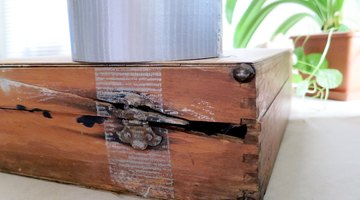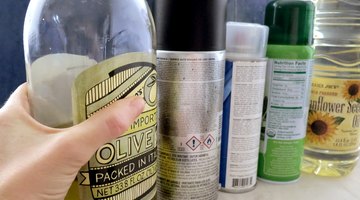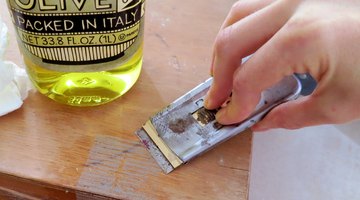How to Remove Duct Tape Residue
You may have been calling it duct tape, but the original name for the repair tape that no home can do without -- originated during World War II because of its ability to repel water -- is actually duck tape.

You may have been calling it duct tape, but the original name for the repair tape that no home can do without -- originated during World War II because of its ability to repel water -- is actually duck tape. Whatever you call it, it sticks so well because it has a unique adhesive that -- unfortunately -- can leave a residue. You may need a solvent to remove this residue.
Duct Tape Adhesive

Unlike masking or cellophane tape, duct tape has a rubber-based adhesive, which is one of the reasons the tape sticks so well. Rubber remains flexible longer than the plastic polymer adhesives used on other tapes, although it can dry out if left on a surface for a prolonged period. Another reason why the adhesive bond is so strong is that the glue is applied in thick coats to the cotton mesh backing of the tape. This means that there's more of it to stay behind when you remove the tape and make a mess.
Duct Tape Residue Removers

The most reliable way to remove duct tape is to soak it with a product made for the purpose; companies that make and sell duct tape offer such products. If you don't have any around the house and don't want to buy it, try metal lubricating spray. It weakens the adhesive bond, allowing you to scrape or rub the adhesive off hard surfaces, such as glass, metal, marble, finished wood and even painted walls. Olive oil and coconut oil also loosen the adhesive bond and make the residue more pliable; plus, they are safer alternatives to use around food preparation areas.
Procedure for Removing Residue

One procedure for removing dried or sticky duct tape residue involves dousing it with solvent or oil and then scraping it off. Spray the tape with adhesive remover or spray lubricant, or soak it with oil; then scrape it off using a paint scraper. You can also simply roll the residue into balls with your finger and pull it off. If you're having trouble getting residue off a textured surface, make a paste with olive oil or coconut oil and baking soda. Cover the residue with the paste; let it sit for 30 minutes to an hour, and then wipe off the paste. It should now be easy to rub off the residue with a cloth.
Tricks for Removing Residue From Fabric

You probably don't want to soak your carpets or upholstered furniture with lubricating spray or olive oil, and you may not have to. You can often remove old residue -- whether it's sticky or not -- with more tape. Simply wrap fresh duct tape around your fist and roll it on the tape, pressing down to bind the residue to the fresh tape. Another strategy is to harden the residue by covering it with a plastic bag filled with ice. Once it hardens, you can chip it off most fabrics with a knife or paint scraper.
The Drip Cap
- You may have been calling it duct tape, but the original name for the repair tape that no home can do without -- originated during World War II because of its ability to repel water -- is actually duck tape.
- You may need a solvent to remove this residue.
- Unlike masking or cellophane tape, duct tape has a rubber-based adhesive, which is one of the reasons the tape sticks so well.
- If you don't have any around the house and don't want to buy it, try metal lubricating spray.
- It weakens the adhesive bond, allowing you to scrape or rub the adhesive off hard surfaces, such as glass, metal, marble, finished wood and even painted walls.
- **
References
Writer Bio
Chris Deziel has a bachelor's degree in physics and a master's degree in humanities. Besides having an abiding interest in popular science, Deziel has been active in the building and home design trades since 1975. As a landscape builder, he helped establish two gardening companies.
Photo Credits
- Heather Fulton/Demand Media
- Heather Fulton/Demand Media
- Heather Fulton/Demand Media
- Heather Fulton/Demand Media
- Heather Fulton/Demand Media
- Heather Fulton/Demand Media
More Articles


